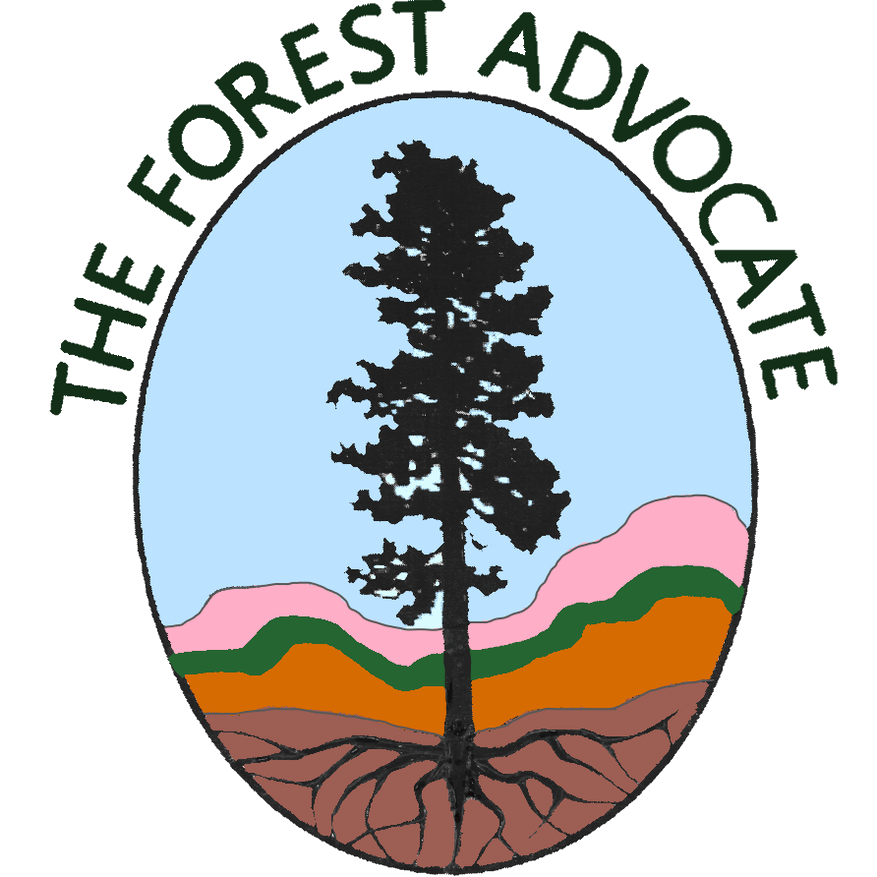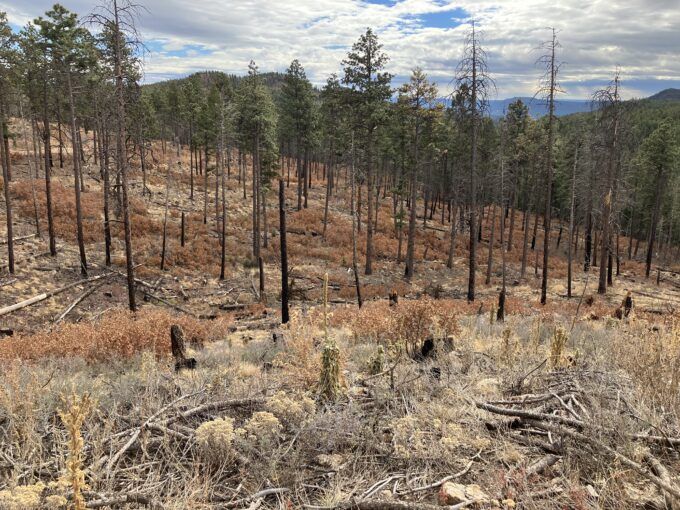|

|
|
|
|

|
La Cueva section of the Santa Fe National Forest, thinned and burned approximately 15 years ago.
|
|
Thin-From-Below in Dry Forests:
Out of the Frying Pan into the Fire?
|
|
In some dry forests, such as the Santa Fe National Forest, conservationists have been quite successful in either greatly reducing or eliminating commercial logging.
|
However, replacing commercial logging in many of these forests is the strategy of widespread and aggressive “thin-from-below,” which means cutting multitudes of smaller trees, often along with some mature trees. Then, the trunks and limbs are cut up (into slash), piled or scattered, and subsequently burned. Following this, prescribed burns are repeated at regular intervals. Some thin-from-below “thinning” prescriptions in the Santa Fe National Forest have called for over 90% of standing trees to be cut.
|
The Forest Service’s primary purposes for implementing thin-from-below treatments are for moderating fire behavior and for ecosystem benefit, i.e. forest health. But do thin-from-below treatments actually accomplish these purposes? And when the full range of impacts and benefits are genuinely considered, are implementing these treatments beneficial in a cost/benefit assessment? Costs include ecological and social costs. This question has not been satisfactorily answered by the Forest Service, other land management agencies, or affiliated scientists.
|
It is highly questionable whether such treatments are a net benefit for moderating fire behavior. On a superficial level, it seems reasonable to remove the majority of trees, so there is less biomass to carry fire, and the tree crowns are separated, reducing fire spread from crown to crown. The prevailing agency paradigm has been that our forests are “overstocked” with trees, primarily due to decades of fire suppression, and that greatly reducing tree densities is the best response. Numerous agency-affiliated studies indicate that our forests historically had many fewer trees per acre than currently exist, and forests were often open and park-like. However, newer research shows that forests historically had areas of both low and high tree densities, in mosaic patterns. An effort is being made by the Forest Service and other land management agencies and organizations to emulate their estimations of historical conditions, even while acknowledging that with climate change, optimal conditions may have greatly altered.
|
A 2016 review of studies addressing fuels treatment effectiveness concludes that there is a “general agreement that thin and burn treatments had positive effects in terms of reducing fire severity, tree mortality, and crown scorch.” It is likely true, at least for a window of time and under certain conditions, that fire behavior can be moderated by treated (cut and burned) areas of forest. But those conditions are generally in situations of low and moderate intensity fire. High severity fires, which are more likely to be destructive to human values, tend to not be substantially moderated by such treatments.
|
Added to these concerns is the question of how many acres burn due to fire escapes from the prescribed burns (both pile burns and broadcast burns) which necessarily follow thin-from-below treatments in order to manage the thinning slash. The Forest Service claims that 99.84% of prescribed burns stay within containment lines. In the Santa Fe National Forest during the spring and summer of 2022, 387,000 acres burned in three separate wildfires precipitated by Forest Service escaped prescribed burns. In the previous decade, only 57,000 acres burned from all other causes, including all other human-caused ignitions. Prescribed burn escapes should be quantified by acres burned and the severity of impacts, and they should be included in a cost/benefit assessment when thin-from-below treatments are being considered – especially in dry forests. In the analysis of the Santa Fe Mountains Landscape Resiliency Project, a large-scale fuels treatment project now underway in the mountains out of Santa Fe, the potential for escaped prescribed burns was not considered at all — even after the extraordinarily destructive 341,000 acre Hermits Peak/Calf Canyon Fire in the Santa Fe National Forest, ignited by two escaped prescribed burns.
|
As importantly, missing from the vast majority of research and analysis by Forest Service and affiliated scientists is a genuine effort to answer questions such as whether thin-from-below forest treatments, regularly followed by prescribed burns, genuinely emulate historical forest conditions as the Forest Service maintains they do. Also, are such thinning treatments genuinely beneficial for forest health, or will they ever be? So far in the Santa Fe National Forest, indications are that the answer is “no,” and the consequences of treatment efforts have included serious ecological damage. Many thinned areas appear to be degraded and dried out, with the soils disturbed and desiccated, the natural understory virtually decimated, and many of the remaining trees unhealthy.
|
The forest in the photo above was cut and burned approximately 15 years ago as part of the 1,100 acre La Cueva Fuel Break Project, an earlier fuels treatment project in the Santa Fe National Forest. The treated areas originally had a fairly dense tree cover, as can be seen in the background of the photo below. Although the project was designed as a shaded fuel break, the prescription was typical of that time for most thinning/burning projects on the east side of the Santa Fe National Forest. In the treated areas, the soils are severely disturbed and appear to be lacking in productivity. Gambel oak, which is characteristic in the area in only very small amounts, seems to be taking over the forest floor, and non-native grasses have become established. The remaining trees generally appear unhealthy, with some turning brown, losing needles, and dying.
|
The agency’s fuels treatment strategy is not emulating historical forest conditions, it’s re-designing the ecosystem into some kind of novel and seemingly dysfunctional state. It’s creating a Frankenforest, a perversion of nature that comes from humans applying their incomplete and superficial understanding of what forest ecosystems actually consist of, and of how all the elements interconnect. Forest ecosystems are much more complex and subtle than a certain number of trees per acre, broken down into categories of tree species and size, etc. Silviculturists may try to create a natural mosaic pattern at times, but often what is left from thin-from-below treatments is mostly uniform swathes of single trees with large spaces in-between and a degraded forest floor.
|
Such trees originally grew in clumps, in “family groupings,” and provided support to each other, both structurally and in support of life processes. When surrounding trees are removed, a single tree is exposed that had always been a part of a system consisting of the whole grouping which may be thought of as a superorganism. Sometimes such lone remaining trees can simply blow over. They often are not as healthy as they were in their original groupings, due to the drying effect of removing much of the surrounding tree canopy, as well as the destruction of the mycorrhizal networks which hold moisture in the soils and facilitate the biological interconnectedness of the trees. It is clear that even after decades, such aggressive “thinning” is not benefiting ecosystems and is in fact harming them.
|
The Forest Service seems to have little interest in monitoring and evaluating the effects of completed thin-from-below treatments over the years and decades. It was stated in a Santa Fe Mountains Project objection response that within project analysis “cost/benefit analyses are not required.” It has taken an appalled public along with conservation organizations and conservation scientists to start to develop monitoring projects and research concerning the effects of such treatments. It may be tempting to consider thin-from-below as the ecologically acceptable alternative to logging, and to see it as at least a partial solution for mitigating land management agencies’ mistakes of the past. However, widespread and aggressive thin-from-below treatments do not appear to be a viable solution. It is possible that limited and light-handed treatments could be beneficial in the cost/benefit analysis on certain landscapes, when implemented within comprehensively planned projects genuinely focused on conservation.
|
GTR-310, the document which is the Forest Service’s framework for improving ecosystem resiliency in Southwestern forests, suggests that land managers should consider fuels treatment projects as “land experiments,” meaning that they should evaluate the effects of each treatment so they can adjust future treatments accordingly. This is known as adaptive management. The document states that “Adaptive management requires feedback obtained from monitoring regarding the success or failure of treatments,” and that “Adaptive management is the ‘rigorous approach for learning through deliberately designing and applying management actions as experiments.’”
|
GTR-310 also states that there should be an “assessment of ecological, economic, and social benefits and costs (e.g., invasive species) of different restoration methodologies and implementation practices, such as methods for treating slash, tree marking approaches, spatial scales of treatment, and frequency of maintenance treatments.” That is, there should be a cost/benefit assessment.
|
If cost/benefit assessments were genuinely done, then it would be possible to realistically analyze proposed thin-from-below fuels treatment projects, because there could be some serious consideration of which treatments promote forest health, and which do not. However, projects are often planned with no concrete monitoring plans in place, although there may be a wish list of suggested monitoring approaches within project analyses, without clear funding or implementation plans. So the basic data required for a meaningful cost/benefit assessment cannot be obtained.
|
Despite leaving behind such degraded landscapes, even decades post-treatment, the widespread and aggressive thin-from-below strategy continues on. It can be safely assumed that our forests were not historically such degraded and unhealthy-appearing ecosystems. The efforts to emulate historical conditions, or to redesign ecosystems into future projected healthy conditions, have in many cases been a failure. We do not know what the long-term impacts will be of proceeding with the same paradigm going forward that has already caused such severe ecosystem damage, but based on past outcomes, we have reason to be extremely concerned for our forests. It’s as if the Forest Service has become a giant machine, churning out thin-from-below treatments with no real regard to the results, nor acknowledgement of the failures.
|
Forest management is complex, and no reasonable strategies should be off the table, but going forward with widespread and aggressive thin-from-below, as if it is already known to meet the agency objectives of fire moderation and promoting forest health, is entirely unacceptable.
|
In the Santa Fe National Forest and across dry forests of the West, conservation scientists and conservation organizations are seeking to create a more ecologically viable paradigm under which to “manage” these forests – one which focuses on holding moisture in forest ecosystems instead of removing large amounts of vegetation, with the resulting soil damage, and drying out of forest landscapes. And one that works with forests’ natural processes instead of trying to impose a human-conceived blueprint onto forests. New conservation research and conservation alternatives are in development. This is the best hope for our forests.
|
And thanks so much for the great response in protecting mature and old growth forests!
|
|
|

|
La Cueva section of Santa Fe National Forest, thinned and burned approximately 15 years ago, showing the contrast between treated and not treated forest.
|
|
|
|
|